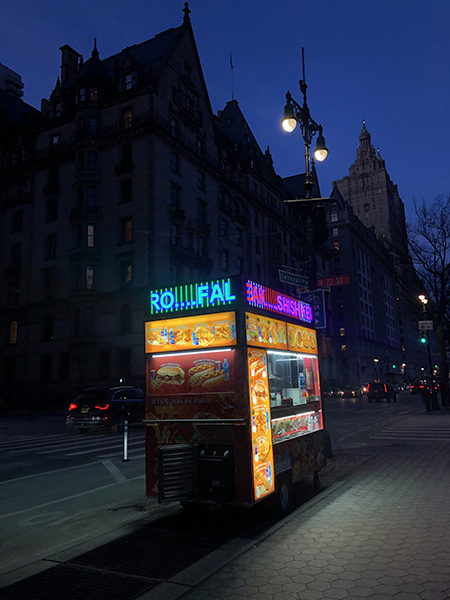
untitled (RO....FAL) 2020
Alone.

untitled (RO....FAL) 2020
Alone.

untitled (ordered) 2020
This stuff is always humbling.
.jpg)
Some of the greens found at the Greenmarket are surprising.
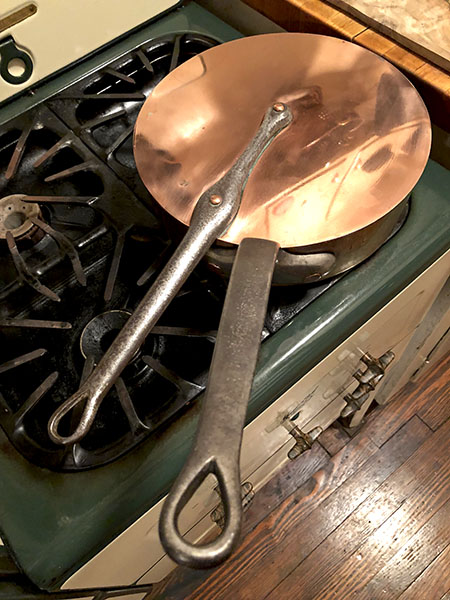
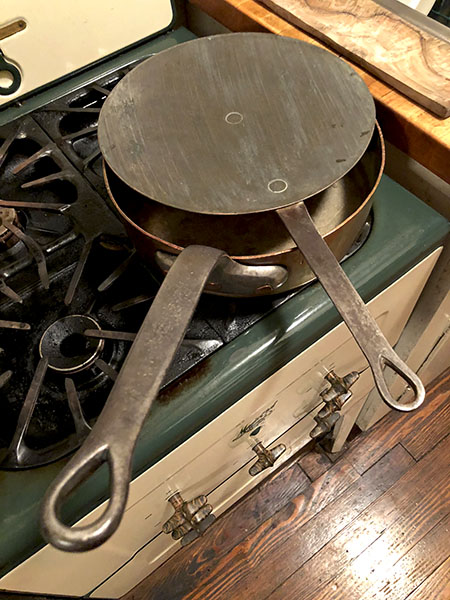
I love my pot.
The large, antique handmade tin-lined copper pot came from a French seller over a year ago, and it quickly became one of my favorite cooking tools.
The lid came on Saturday.
I've been looking for a proper copper cover, a 'universal-style' flat lid, ever since it arrived, and yesterday 'the ship came in' again, so to speak. It took a long time to find one of its size, but when I finally did, it was a perfect match, a perfect fit as a cover, and it looked like it could have been fashioned by the same maker, a long time ago. It's also in perfect shape, top, bottom, and wrought iron handle.
In addition, as a universal lid, meaning it's flat and doesn't have to correspond with the exact diameter of the vessel, I can use it on at least five different pots and pans that I already have, made of various materials. It hangs on an old square-cut nail on the kitchen wall, so it will always be immediately accessible.
The 27cm (10.5 inch) high-sided tin-lined copper pot in the picture weighs 8 pounds, the lid 2 pounds. Heavy is good in the pots and pans world.
Along with the heavy canvas bags of groceries I regularly lug home from the Union Square Greenmarket, this pot and others I use, including some that have been with me for many decades, whether steel, copper, cast iron, or enameled cast iron (all materials outweighing the vintage clear Pyrex pots), constitute my upper body exercise routine.
While these copper treasures don't come cheaply, the price new of anything similar to what I have acquired 'used' is totally off the chart, and the product is likely to be inferior, even aside from considerations of aesthetics and, well, soul.
I've always been very lucky in the used kitchen utensil market, as I have been in the used anything market.
My ultimate excuse for an indulgence in this area (I mean, nobody needs copper pots) is the happiness cooking brings to both of us, and others, when we can share, and the thought of how much we save by not depending on commercial kitchens.
Still, there are good arguments for these things.
NOTE: I don't polish my copper pans; I use them (although I used to occasionally polish the new copper tubs in my 1760 Providence house; I also used them)
.jpg)
untitled (golden beets) 2017
The image of these gorgeous golden beets, caught while I was documenting a Greenmarket purchase from Norwich Meadows Farm, was a fluke, but I like it. A proper focused portrait will eventually appear on the Food Blog.
UPDATE: The 'proper focused portrait' I promised now appears on the Food Blog, inside this entry
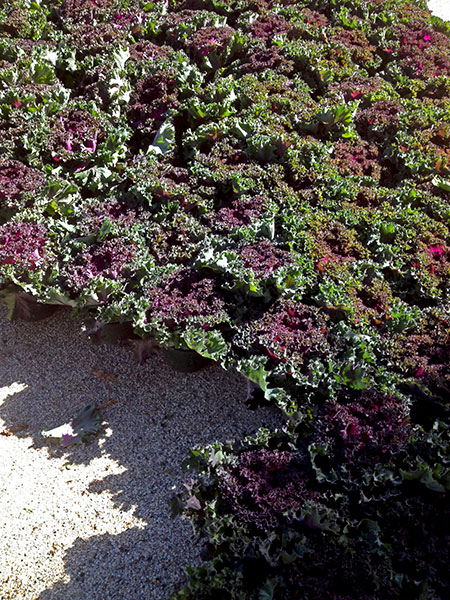
untitled (kale wave) 2013
I saw this wave of ornamental kale assembled inside the pedestrianized area of Broadway just to the east of the Flatiron Building today, and snapped this picture with my phone camera. The little guys were waiting to be distributed around the neighborhood, where they will be transplanted into large pots or sidewalk cuts, usually at the base of a small tree. One of New York's ways of recognizing the arrival of fall is to replace the flowering plants which had graced the streets during the summer (yeah, things certainly have changed around here since the 70s and early 80s).
I love kale, and I think I appreciate the ornamental kind almost as well, but I can never quite empty my head of the knowledge that even these plants are actually quite edible. In a pinch they could ward off starvation, but lets hope it won't be a long hard winter.
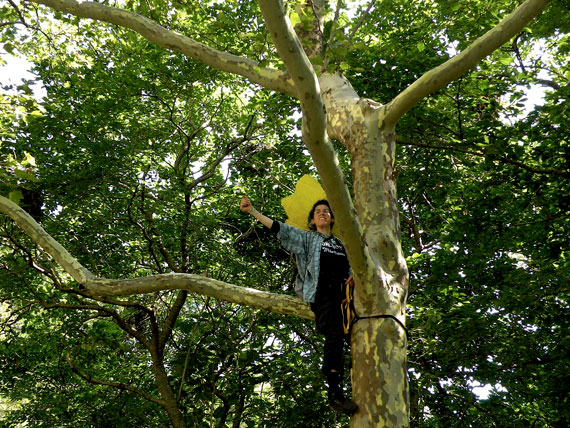
Jessica Sunflower planted in CIty Hall Park
UPDATE: A public hearing concerning the City's proposed new rules will be held next Tuesday, August 10 at Chelsea Recreation Center, 430 West 25th Street, at 11:00am. It should be very colorful. The New York City Community Garden Coalition (NYCCGC) is urging its supporters to testify about the importance of making community gardens permanent. Information can be found on the Coalition’s web site, including the proposed rules themselves, the expiring 2002 agreement, and a history of the evolution of New York City community gardens.
New York City appears to have officially abandoned its efforts to preserve the 500 community gardens which have been protected from development since 2002 by the Spitzer Agreement ("Preservation Agreement"). That compact, which ended a hard-fought battle begun more than 20 years earlier, saved hundreds of community gardens, but it expires on September 17 this year.
Proposed Department of Housing and Preservation (HPD) rules will permit these precious urban green spaces to be legally transferred for commercial development. These popular and flourishing bootstrap gardeners' oases had replaced neighborhood vacant lots where buildings had been abandoned by landlords following the flight of residents to the outer boroughs and the suburbs during the sixties and seventies.
These older structures, neglected and often torched, but ultimately leveled in any case, all eventually became city property. The City hoped to profit from their sale and the tax revenues which would follow their development, but there was no commercial interest in the properties until residents, both old and new, had worked hard to successfully rebuild and improve their neighborhoods.
The communities which have fought for these spaces and nurtured them for years are understandably very angry. Yesterday Jessica Sunflower and some friends decided to bring the Time's Up! campaign to preserve these gardens down to City Hall itself. The precise venue chosen was City Hall Park, on the doorstep of both the Mayor's office and the City Council Chamber. Sunflower managed to climb into a tree planted in the Mayor and Council's own official "garden", and she was joined on the ground by some serious community advocates.
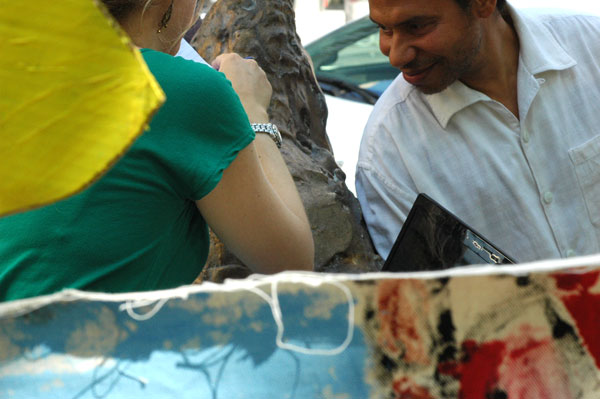
modern activism: back on the ground, even as Sunflower was being ushered into a police vehicle, supporters were busy broadcasting the action from a laptop resting on the plinth of a bronze sculpture at the edge of the park
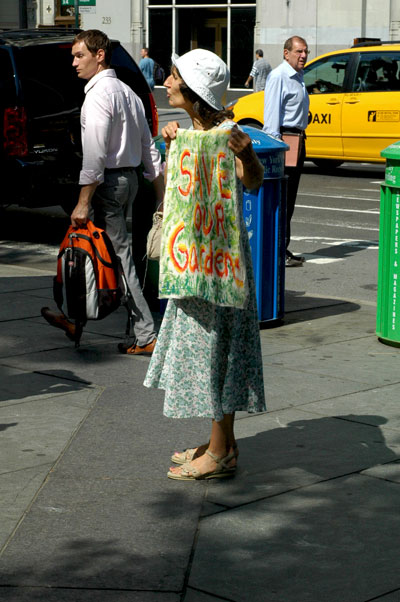
the voice of one crying in the City Hall wilderness - will it be heard?
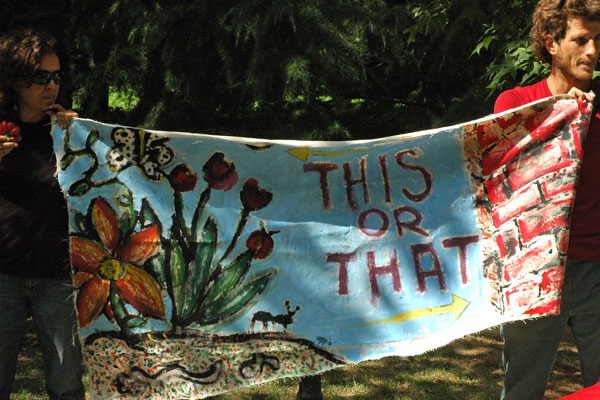
for thirty years, the communities have chosen gardens over brick
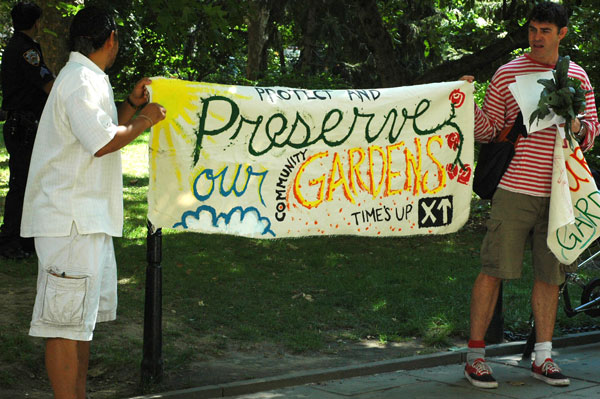
kale bouquet: the Times once described New York's more successful community gardens as "spectacular stretches of kale-toned respite"
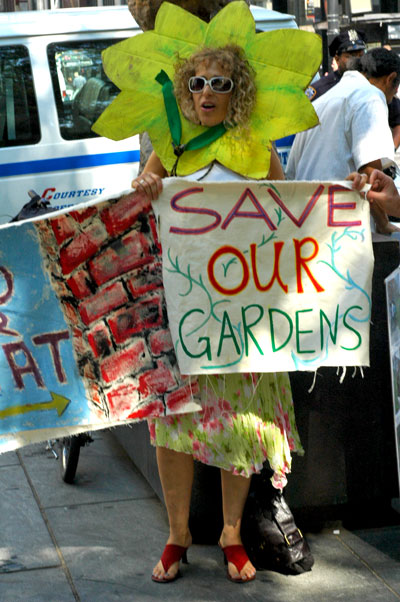
the sunflower petals abandoned by the prisoner while she was being removed from the tree were quickly salvaged and recycled back on the ground
[image at the top by Rebekah McCabe, from a Flickr set uploaded by Barbara Ross]
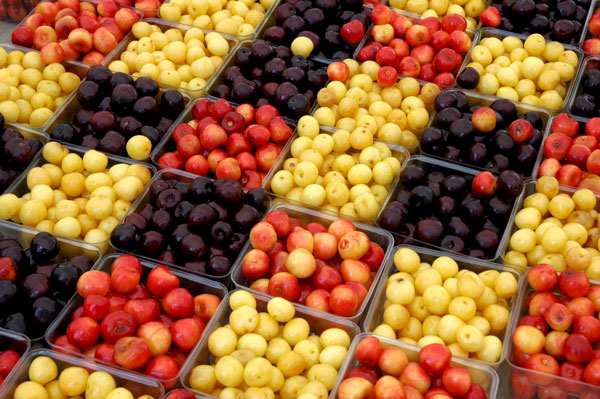
This image includes only one segment of a vast checkered display set up in the Union Square Greenmarket last Friday by Samascott Orchards, of Martin van Buren's Kinderhook, New York. The cherries were going fast.
Speaking of van Buren, I just learned that the bewhiskered knickerbocker, incidentally the first president from New York (and the first born in the U.S.), was the first one for whom English was not a first language. We're still waiting for the second, and, if we all survive, there should be many more.
The boy went far. If he were alive today, what do we think he'd say about our modern Know Nothings? But maybe there's no real parallel, since his family, and many other Dutch settlers, had been busy, and dominant, in the upper Hudson valley since the early 1600's, before English, or the English had subsumed all. Also, the Dutch were pretty white, and definitely not Catholic. Today's Know Nothings have to find a way to get around the fact that if there are any "illegals", it's the people who stole the West, indeed the entire Western Hemisphere, from those who were there first.
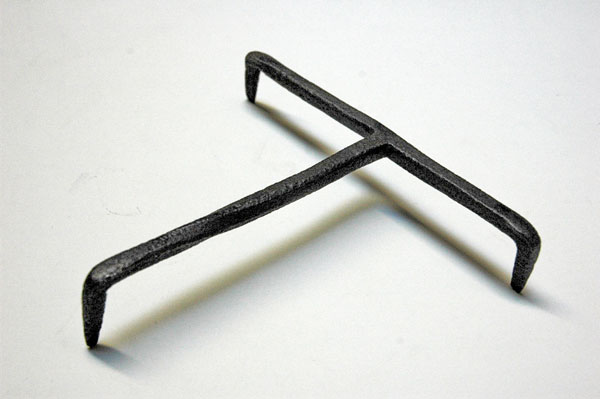
wrought iron trivet, likely late eighteenth century, probably Rhode Island 7" x 5.75" x 1.75"
I'm normally almost dysfunctional if asked to speak in front of a group, but I hardly hesitated when Austin Thomas asked if I would be a part of “One Image, One Minute: Significant People Present Significant Images”. The event, hosted at Hyperallergic on June 22, was a benefit for Camp Pocket Utopia, a creative summer project, social school and free arts camp for kids, being put together by Thomas and the nonprofit space Norte Maar. Their ambitious program, to be located at Rouses Point in upstate New York, will be based on a learning model created at Black Mountain College, as interpreted by Thomas, who describes it further:
The Camp hopes to inspire a conversation amongst artists, creative thinkers, and the community, empowering participants and observers to think for themselves while offering a free arts camp for the kids of Rouses Point, NY, and the surrounding North Country.
I was honored, and eventually psyched (almost) to be a part of the terrific "show and tell" organized as a fundraiser for the project. Thomas had asked twenty-five people to each submit an image of something very important to them, and to talk about it for one minute. Almost immediately I thought of the trivet shown at the top of this post, and told her I would contribute, since I knew I wouldn't have any trouble talking about something I know well and which has meant a lot to me.
I only had to stand up there for 60 seconds. How hard could that be? It turned out that the hardest part was the time restriction. I didn't want to read from notes, and I didn't want to stress out by doing too much preparation, but, less than an hour before leaving for Williamsburg, when I first did a run-through, I realized I had enough material for five or ten times my time slot.
We were told we would be called up in alphabetical order, so I had plenty of time while I waited. Grade school flashback: Once again Wagner was going to be the last to give his report (I'd like to think Austin had thought of that conceit, for its connection to her larger, school-ish project). I managed to pare it down a lot from my piece while I sat waiting my turn, but much of the story survived.
It was a successful experiment. It made for a thought-provoking evening, and it drew a great group of people - on both sides of the tiny apron stage.
One of the reasons the trivet had come to my mind must have been that it was a simple and beautiful thing. It was a rough material, yet it had left the forge with an awesome grace. It was totally functional, but perfectly sculpted: Each of its branches was chamfered along its entire length and the 90-degree twist of the longest arm was an artist's aesthetic gesture and, perhaps, a strengthening fillip.
It was also a thing whose description, and even its personal importance, I originally thought could be described in one minute.
In spite of, or perhaps because of, my enthusiasm for contemporary visual art, It had not occurred to me to look there for a subject. The reservoir was too vast, and I probably sensed that I'd never be able to focus on the one work which, using the adjective in Austin's invitation, was particularly "important to me". I had looked elsewhere for my subject.
For many years I had created, and still cherish, an environment pretty much removed from modernism of any kind. I chose to share something from that world; I chose this trivet, a humble piece of worked ("wrought") iron.
It was created in southeastern New England, probably somewhere in Rhode Island, and probably in the late eighteenth century. Its working purpose: to elevate a plate, pan or heavy pot above hot coals spread onto a hearth, or, alternatively, above a table surface which would be damaged by a hot vessel.
The material is bog iron, which was once found locally near the surface of the ground (no longer of any practical interest except to antiquarians). It's a very low-carbon metal (unlike steel), and easily malleable. It was the work of a skilled blacksmith. It has a characteristic "grain" (again, unlike steel). Because of its purity, it's extremely resistant to rusting.
I brought it with me from Rhode Island 25 years ago, when I decided to give up the simple mid-eighteenth-century clapboard house in Providence which I and my partner at the time had bought (in 1970). We restored it [I have to say, "lovingly" restored it] over a number of years, until it looked like it had never needed restoring. It was both a home and a house museum: I thought we would live there until we died, and it was furnished entirely with things appropriate to its date, its geography and the particular economic circumstances of its original occupants. There was essentially no upholstered furniture.
This trivet was a working part of that house, and so was I.
The curatorial assignment my partner and I had undertaken (after we learned the real antiquity of what we had initially thought was just an old rundown house, a very rundown house) precluded living with contemporary art, in spite of the interest we both had for the art of our own time. Instead, for 15 years I lived with art that was contemporary to the earliest period of the house, and there was very little of that.
In the years of assembling things for the house I consciously avoided interesting examples of regional New England folk art, even though it wouldn't have been difficult to secure such things, because it seemed so unlikely that the interior of our very modest, and genuinely urban, house would have seen much of the folksy kind of decoration so prized today. Also, Shaker design did not yet exist at the time the house was built, and when it did, the communities which produced it were nowhere near Rhode Island. Much of what I did have may have looked "Shaker", but I can't say any of it was.
But I kept my passion for both historic and contemporary art, even if I was sheltered under a very old roof and beside a large, fully-equipped cooking hearth. Beyond my newly-founded antiquarian interests, I still wanted to be surrounded by art. The house itself was an incredibly understated design, and I found myself going for the simplest, most elegant forms of practical furniture and artifacts, in wood, glass, metal and pottery: There was that fabulous Mochaware mug with a geometric shape and pattern which would not have looked out of place in the Bauhaus, and that beautiful provincial Sheraton side chair with squared, vertical splats, that could have posed as a Josef Hoffman prototype.
I did some serious cooking in that house, in both the almost-modern kitchen and on the open hearth (I cook more than ever today, but without those wood fires), so I'm not surprised that I almost immediately fell in love with the small tool which I had picked up, probably in an old barn, soon after we were first able to use the fireplaces.
My partner and I broke up, and when I finally decided to decamp to New York, in 1985, I sold much of its contents and put the house up for sale.
I brought the trivet with me. Today it rests only on the counter or the table. Its cooking days may be over, but I prize it as much as I ever did, for its function, its beauty and its associations. Although there are hundreds of drawings and paintings hanging on our walls, when guests are here, especially for dinner, I'm just as likely to pull this little black tripod off the kitchen counter and play "show and tell" with it as anything else in the apartment.
So is it sculpture? I seems to defy categories. Although it may end up on the table at many meals, while the pot it supports will return to the kitchen, the trivet remains. I never tire of looking at it.
The other presenters at the benefit were Laura Braslow, Deborah Brown, Paul D'Agostino, Anna D'Agrosa, Jen Dalton, Kianga Ellis, Louise Fishman, Veken Gueyikian, Rachel Gugelberger, Chris Harding, Valerie Hegarty, Roger Hodge, Lars Kremer, Ellen Letcher, Matthew Miller, Brooke Moyse, Ellie Murphy, James Panero, Gravelle Pierre, Cathy Nan Quinlan, Paul Rome, Adam Simon, Jonathan Stevenson, and Douglas Utter.
[someday soon I hope to set up a gallery devoted specifically to images of the house]

Today is the eighth anniversary of this blog.
I said it last year, and I'm delighted and incredibly privileged to say it again: This is also the anniversary of what turned out to be the most important event in my life, the night Barry and I met (now nineteen years ago).
Last year I also wrote, looking at the world outside our circle of close friends, that I was "more upbeat about the world" than I had been the year before, the eighth year of our second Bush, adding, "but only a bit". That hasn't changed, a bit.
And happy birthday, Paddy Johnson!
[the image is of a portion of the street number on the glass above one of the Art Deco entrances of the former Port Authority Commerce Building (1932), 111 Eighth Avenue the wall seen several feet behind the glass is covered with gold leaf]